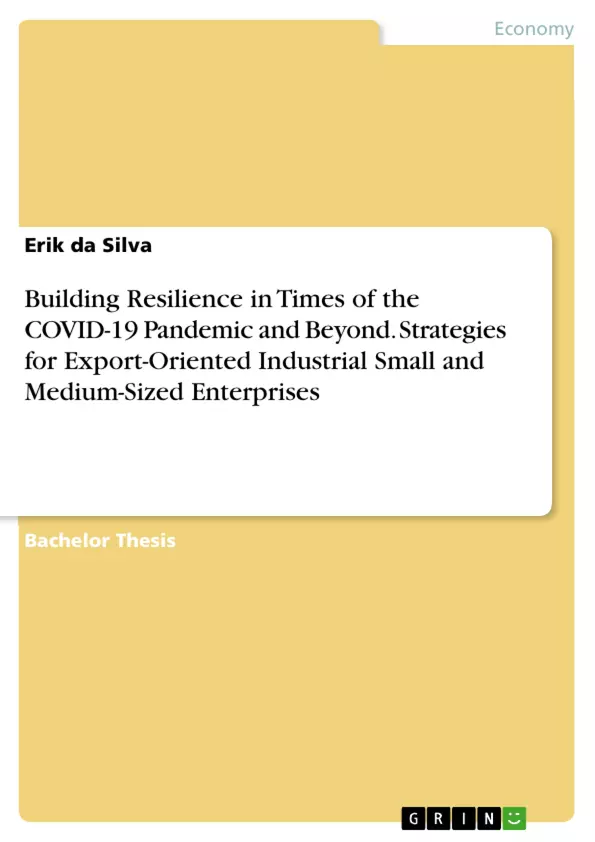This piece of scientific work aims to answer the following research questions. These questions were derived as the primary reasons for this thesis and were motivated due to the current global health and social crisis, the economic disruptions caused by it all over the world, the need to better understand the effects of it on businesses and the need to investigate the best ways to be able to better cope with future disruptions.
Main question: How can export-oriented industrial SMEs build resilience in times of the COVID-19 pandemic and beyond? Sub question 1: How has the COVID-19 pandemic affected the global economy in the context of international trade? Sub question 2: What have been the main challenges faced by B2B export-oriented SMEs during the COVID-19 pandemic?
Owing to the new and emerging field of business research that the COVID-19 pandemic has created, research has been developing on the topic. Researchers have primarily concentrated on specific issues such as understanding the impacts of the pandemic on the supply chain, import and export flows and trade policies. Often lacking a practical-oriented application of findings for Managers and their organizations and a focus on the challenges faced by export-oriented Small and Medium-Sized Enterprises (SMEs).
The purpose of this bachelor thesis is to examine the impacts of the COVID-19 pandemic on international business operations and especially in Business to Business international sales and marketing focusing first and foremost on SMEs, and to provide a concise overview concerning the topic of international trade disruptions during the pandemic as well as strategies and better practices for responding to and mitigating these risks and threats.
Inhaltsverzeichnis (Table of Contents)
- Acknowledgements
- Table of Contents
- List of Figures
- List of Tables
- List of Abbreviations/Glossary
- Executive Summary
- 1. Introduction
- 1.1 Background
- 1.2 Problem Description
- 1.3 Research Questions
- 1.4 Purpose and Goals
- 1.5 Thesis Outline
- 1.6 Methodology and Research Process
- 2. The Effects of COVID-19 on the Global Economy
- 2.1 Across Different Countries & Regions
- 2.1.1 The Americas
- 2.1.2 Europe
- 2.1.3 Africa
- 2.1.4 Asia
- 2.1.5 Oceania
- 2.2 The Impact on International Trade
- 2.2.1 Across Different Industries
- 2.3 Summary
- 3. The Implications of COVID-19 on SMEs' International Business Operations
- 3.1 B2B Sales & Marketing
- 3.2 Supply Chain & Manufacturing
- 3.3 Finance & Cash Flows
- 3.4 Personnel
- 3.5 Summary
- 4. Strategies & Suitable Practices for Increased Export Resilience
- 4.1 The Digital Factor
- 4.2 Strategic Sales & Marketing in Times of Disruption
- 4.2.1 Prospecting
- 4.2.2 Approach
- 4.2.3 Product Presentation, Overcoming Objections, and Closing the Deal
- 4.2.4 Follow-Up
- 4.3 Strategic Supply Chain & Manufacturing Management
- 4.4 Strategic Cash Flows & Financial Management
- 4.4 Strategic Personnel Management
- 4.5 Managerial Implications
- 5. Conclusion
- 5.1 Limitations and Future Outlook
- List of References
- Appendix
Zielsetzung und Themenschwerpunkte (Objectives and Key Themes)
This bachelor thesis aims to examine the challenges faced by export-oriented industrial SMEs in the wake of the COVID-19 pandemic and explore strategies for building resilience in their international business operations. The research focuses on identifying key areas where SMEs can enhance their adaptability and preparedness for future disruptions.
- The impact of COVID-19 on the global economy and its specific effects on international trade.
- The implications of the pandemic on SMEs' international business operations, including sales and marketing, supply chain management, finance, and personnel.
- Strategies and best practices for increased export resilience, emphasizing digitalization, strategic sales and marketing, supply chain management, financial management, and personnel management.
- Managerial implications for SMEs to navigate the post-pandemic business landscape and enhance their long-term sustainability.
- Limitations of the research and future outlook for the field of export resilience in SMEs.
Zusammenfassung der Kapitel (Chapter Summaries)
Chapter 1 introduces the research problem, outlining the context of export-oriented industrial SMEs facing unprecedented challenges during the COVID-19 pandemic. The chapter defines the research questions, specifies the purpose and goals of the study, and outlines the methodology employed. Chapter 2 analyzes the global economic impact of COVID-19, examining the effects on various regions and industries. Chapter 3 delves into the implications of the pandemic on SMEs' international business operations, focusing on sales and marketing, supply chain management, finance, and personnel. Chapter 4 explores strategies and best practices for building export resilience, including digitalization, strategic sales and marketing, supply chain management, financial management, and personnel management. It also highlights managerial implications for navigating the post-pandemic business landscape. Chapter 5 summarizes the findings and concludes with a discussion of limitations and future research directions.
Schlüsselwörter (Keywords)
This bachelor thesis examines the resilience of export-oriented industrial SMEs in the face of the COVID-19 pandemic. Key areas of focus include the global economic impact of the pandemic, its implications on international trade, and the specific challenges faced by SMEs in areas like sales and marketing, supply chain management, finance, and personnel. The research explores strategies for building resilience, emphasizing digitalization, strategic sales and marketing, supply chain management, financial management, and personnel management.
- Citar trabajo
- Erik da Silva (Autor), 2022, Building Resilience in Times of the COVID-19 Pandemic and Beyond. Strategies for Export-Oriented Industrial Small and Medium-Sized Enterprises, Múnich, GRIN Verlag, https://www.grin.com/document/1347695



